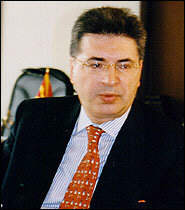 RELATIONS WITH INTERNATIONAL ORGANIZATIONS RELATIONS WITH INTERNATIONAL ORGANIZATIONS |
 STABILITY PACT STABILITY PACT |

Probably the largest initiative ever undertaken in Southeastern Europe, or the "second Marshall's Plan" as some like to call it, was adopted in Cologne on 10 June 1999, at the EU's initiative. The following quote from the Macedonian Minister of Foreign Affairs Srdjan Kerim describes what the Stability Pact means for every Macedonian citizen: " the Stability Pact is a framework for regional cooperation, regional stability and democratic development. The Stability Pact is the first framework whereby the countries from the region are partners."
In the founding document, more than 40 partner countries and organizations undertook to strengthen the countries of south Eastern Europe "in their efforts to foster peace, democracy, respect for human rights and economic prosperity in order to achieve stability in the whole region". Euro-Atlantic integration is promised to all the countries in the region. At a summit meeting in Sarajevo on 30 July 1999, the Pact was once again solemnly sealed.
The Stability Pact is the first serious attempt by the international community to replace the previous, reactive crisis intervention policy in South Eastern Europe with a comprehensive, long-term conflict prevention strategy. The idea for the Stability Pact arose in late 1998 and thus predates the Kosovo war. But the NATO intervention undoubtedly acted as a catalyst in strengthening international political will for coordinated and preventive action in the region.

The Stability Pact is based on the most important experiences and lessons from worldwide international crisis management. Conflict prevention and peace building can be successful only if they start in parallel in three key sectors: the creation of a secure environment, the promotion of sustainable democratic systems, and the promotion of economic and social well being. Only if there is progress in all three sectors can a self-sustaining process of peace get underway.
The Republic of Macedonia is a partner of the Stability Pact, along with the following countries in the region: Albania, Bosnia-Herzegovina, Bulgaria, Croatia, Hungary, Romania, Slovenia, Yugoslavia and Turkey.
The Stability Pact has 3 Working Tables with about 200 projects under the Quick Start Program (start of projects between March 2000 and March 2001) with an overall financial engagement of 2.4 billion Euro for the region as a whole. Working Table I is dealing with Democratization & Human Rights, Working Table II with Economic Reconstruction, Development and Co-operation, as for Working Table III with Security issues (one Sub-table Security and Defense, one Sub-table Justice and Home Affairs).
From the very begining, the Republic of Macedonia has strongly supported the Stability Pact. The Stability Pact for South East Europe lists the areas of economic cooperation and trade relations between the regional partners between the region and the rest of Europe and ultimately, between the region and the rest of the world. Macedonia is fully applying the concept of the international community for co-operation with all neighboring and adjacent countries of the region.
 Quick Start Package for Macedonia in the field of infrastructure and investments Quick Start Package for Macedonia in the field of infrastructure and investments |
 1. Infrastructure - Blace Border Crossing 1. Infrastructure - Blace Border Crossing |
Starting date: January 6 2002
Implementing Agency: European Commission,
Donors: European Commission, Portugal, USA
Status of Implementation
EC € 4 mn grant (Macedonia side)
EC € 2 mn grant (Kosovo side and overall project design)
USA € 2 mn (construction of remote parking Macedonia side)
Portugal € 0.5 mn (construction of remote parking Kosovo side)
 2. Infrastructure - Demir Kapija-Gevgelija Greek border 2. Infrastructure - Demir Kapija-Gevgelija Greek border |
Starting date: January 6 2002
Implementing Agency: European Investment Bank,
Donors: EIB, |
Objective
Improvement of a critical section of the corridor 10 North-South route near the border with Greece, which is a main link between the region and the European Union.
Total Initial Amount: € 32.000.000
 3. Power Sector Investment Study - Priorities in generation and transmission investments 3. Power Sector Investment Study - Priorities in generation and transmission investments |
Starting date: March 31 2000
Implementing Agency: Canadian International Development Agency, European Commission,
Donors: Canada, European Commission
Objective
To provide a selective approach to investments in the fields of generation and transmission.
 4. Infrastructure - Municipal & Environmental Action Program ("MEAP") 4. Infrastructure - Municipal & Environmental Action Program ("MEAP") |
Starting date: March 22 2001
Implementing Agency: EBRD,
Donors: Denmark, EBRD, Germany, Greece, Macedonia, Portugal, Switzerland, U.S.A.,
Status of Implementation
Total Cost: 69.5 €
 5. Infrastructure - Trade and Transport Facilitation Program for Southeast Europe (TTFSE) 5. Infrastructure - Trade and Transport Facilitation Program for Southeast Europe (TTFSE) |
Starting date: March 16 2001
Beneficiaries: Albania, Bosnia-Herzegovina, Bulgaria, Croatia, FYR of Macedonia, Romania,
Project Type: Infrastructure
Status of Implementation
Total cost: US$103.5 million equivalent (whole program)
Still one of the most important projects from the Stability Pact concerning Macedonia is the PAN-European Corridor 8 project, which is supposed to connect the Italian coast with the Black Sea via Albania, Macedonia and Bulgaria. Other countries involved in this project are Romania and Turkey.

"The Corridor 8 in Macedonia is actually the railway towards Bulgaria. We have started the construction from our own budget. For the finalization of the overall project of the railway we need about 200 million US dollars. The Corridor 8 is the biggest task for the Ministry of Transport because Macedonia, Bulgaria and Albania have not signed yet the Memorandum on Corridor 8. Hopefully, the Memorandum will be signed soon", the Minister of Transports and Communications Ljupco Balkovski stated.

Besides the Corridor 8, another huge project is the North-South corridor, better known as Corridor 10. The construction of this corridor will force great responsibility on the only road company in Macedonia - the Makedonija Pat. "The Northern Corridor is in process of construction. The area between Tetovo and Gostivar has already been built. Our government is working on the construction of the Skopje-Tetovo section - partly financed from the World Bank and the European Bank. And when this road opens MakedonijaPat will handle the maintenance," says Georgievski Spasen, General Manager of Makedonija Pat .
However, Makedonija Pat will not be left alone in dealing with these challenges. "Under pressure from the IMF, we are being forced not to have monopoly on the road maintenance in the country. The time when there will be tenders for road maintenance is coming very soon. The main goal of the Government is not to have a monopoly company maintaining, but a number of different construction companies providing maintenance. My job as General Manager of this company is to provide good conditions for its privatization of this company, to make it a successful one able to compete with the rest of the companies that will be on the market," he adds. |

